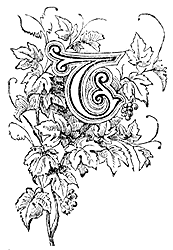 |


HE Danes in the ninth century were the most frightful enemies that England had ever known. Strong, brave, ruthless, as cruel as they were valiant, sparing neither woman nor babe, these heathens carried the Raven banner all along the south and eastern shores of our island. In 870 their attacks were even more than ordinarily ferocious, and it is no marvel that in the liturgy of the Church ran the mournful petition, "From the fury of the Danes, Good Lord, deliver us;" for they had laid in ruins the Abbeys of Croyland, Medhamsted (Peterborough), Marney, Ramsey, and Ely, and ravaged the land with sword and fire. Their strategy was to occupy all the best stations on the coast, and then to post their forces across the island. They now attacked East Anglia. The East Anglians had at the time a king famed for his piety and integrity, a brave warrior also, who defended his people with great resolution. But overpowered by the myriads of red-haired warriors who came against him, Edmund was defeated and made captive. The battle was fought near Hoxne, in Suffolk, on the
banks of the Waveney, near Eye.
"Being hotly pursued by his foes," says Sir Francis Palgrave in his charming Anglo Saxon History, "the king fled to Hoxney and attempted to conceal himself by crouching beneath a bridge, now called Goldbridge. The glitter of his golden spurs discovered him to a newly married couple, who were returning home by moonlight, and they betrayed him to the Danes. Edmund, as he was dragged from his hiding-place, pronounced a malediction upon all who should afterwards pass this bridge on their way to to be married, and so much regard is paid to this tradition by the folks of Hoxne, that now (1831), or at least within the last twenty years, no bride or bridegroom would venture along the forbidden path."
An account of Edmund's death was given by his swordbearer, who lived to a great age, and was never weary of repeating the sad story to the courtiers of Athelstane. The Danes fettered and manacled the brave king, and treated him with every species of cruelty and insult. They, at last, offered him his life if he would deny Christ, and worship their gods; he firmly refused. He was cruelly scourged; then tied to a tree and shot at with arrows as at a mark; but this English St. Sebastian remained resolute in his faith, praying to Christ amidst all his sufferings, until, weary of cruelty, Inguair and Ubba struck off his head with an axe and threw it into the thicket.
Edmund was justly canonized as saint and martyr, and his name is still retained in the Church Calendar.
The ancient service contains the following legend:-
As soon after the martyrdom as possible, a party of his friends ventured into the wood to seek for his remains. They were searching everywhere all through the wood, when one cried in half-mocking despair, "Where art thou, comrade?" the ordinary cry of the woodman. To their amazement they heard an answer, "Here - here - here." They then constantly repeated the cry, and were always answered, till, following the sound, they came to where Edmund's head lay between the fore paws of a great grey wolf, - a greedy, hungry beast, - but who dared not touch the head he held, but guarded it against wild beasts. "Then were they astonished at the wolf's guardianship." The animal let them take the head from him, and followed them as they bore it towards the town, as if he were tame, while they went, thanking God for all His wonders. When they reached the town the wolf left them and went back to his woods.
The remains were removed to a town originally called Badrichesworth, and there they were buried, the place, henceforward, taking the name of Bury St Edmunds.
Canute, as if in atonement for the crime of his countrymen, founded here a monastery to St. Edmund, one of the most sumptuous then in England; a few fragments of it only remain; but the name of "Edmund" is a household name in Norfolk and Suffolk, attesting, perhaps, at first the reverential memory in which they hold St. Edmund.
|
 |